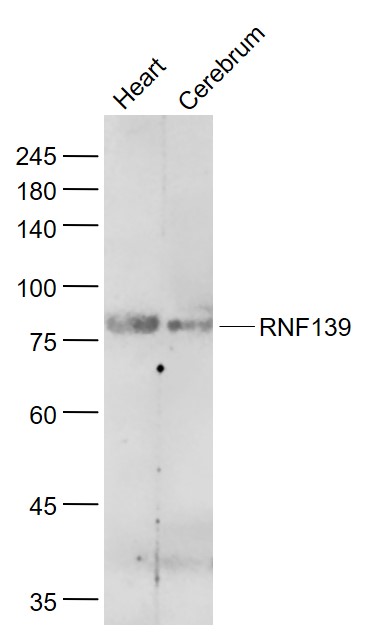
Rabbit Anti-RNF139 antibody
HRCA1; RCA1; Ring finger protein 139; TRC8; RN139_HUMAN.
View History [Clear]
Details
Product Name RNF139 Chinese Name Ring finger protein139抗体 Alias HRCA1; RCA1; Ring finger protein 139; TRC8; RN139_HUMAN. Research Area Tumour immunology Signal transduction Immunogen Species Rabbit Clonality Polyclonal React Species Mouse, (predicted: Human, Rat, Chicken, Dog, Pig, Cow, Horse, Rabbit, Sheep, ) Applications WB=1:500-2000 ELISA=1:5000-10000 IHC-P=1:100-500 IHC-F=1:100-500 IF=1:100-500 (Paraffin sections need antigen repair)
not yet tested in other applications.
optimal dilutions/concentrations should be determined by the end user.Theoretical molecular weight 76kDa Cellular localization cytoplasmic The cell membrane Form Liquid Concentration 1mg/ml immunogen KLH conjugated synthetic peptide derived from human RNF139: 501-600/664 Lsotype IgG Purification affinity purified by Protein A Buffer Solution 0.01M TBS(pH7.4) with 1% BSA, 0.03% Proclin300 and 50% Glycerol. Storage Shipped at 4℃. Store at -20 °C for one year. Avoid repeated freeze/thaw cycles. Attention This product as supplied is intended for research use only, not for use in human, therapeutic or diagnostic applications. PubMed PubMed Product Detail The protein encoded by this gene is a multi-membrane spanning protein containing a RING-H2 finger. This protein is located in the endoplasmic reticulum, and has been shown to possess ubiquitin ligase activity. This gene was found to be interrupted by a t(3:8) translocation in a family with hereditary renal and non-medulary thyroid cancer. Studies of the Drosophila counterpart suggested that this protein may interact with tumor suppressor protein VHL, as well as with COPS5/JAB1, a protein responsible for the degradation of tumor suppressor CDKN1B/P27KIP.
Function:
E3-ubiquitin ligase; acts as a negative regulator of the cell proliferation through mechanisms involving G2/M arrest and cell death. Required for MHC class I ubiquitination in cells expressing the cytomegalovirus protein US2 before dislocation from the endoplasmic reticulum (ER). Affects SREBP processing by hindering the SREBP/SCAP complex translocation from the ER to the Golgi, thereby reducing SREBF2 target gene expression. Required for INSIG1 ubiquitination. May be required for EIF3 complex ubiquitination. May function as a signaling receptor.
Subunit:
Interacts with VHL. Interacts with MHC class I and HM13. Component of SCAP/SREBP complex composed of SREBF2, SCAP and RNF139; the complex hampers the interaction between SCAP and SEC24B, thereby reducing SREBF2 proteolytic processing. Interacts with SREBF2 (via C-terminus domain). Interacts with SCAP; the interaction inhibits the interaction of SCAP with SEC24B and hampering the ER to Golgi transport of the SCAP/SREBP complex. Interacts with SEC24B. Interacts with INSIG1 and INSIG2. Interacts with EIF3F and EIF3H; the interaction leads to protein translation inhibitions in a ubiquitination-dependent manner.
Subcellular Location:
Endoplasmic reticulum membrane; Multi-pass membrane protein.
Tissue Specificity:
Highly expressed in testis, placenta and adrenal gland. Moderate expression in heart, brain, liver, skeletal muscle and pancreas, and low expression in lung and kidney.
Post-translational modifications:
Autoubiquitinated. Ubiquitination is induced by sterol and leads to ist degradation via the ubiquitin-proteasome pathway.
DISEASE:
Defects in RNF139 may be a cause of renal cell carcinoma (RCC) [MIM:144700]. It is a heterogeneous group of sporadic or hereditary carcinoma derived from cells of the proximal renal tubular epithelium. It is subclassified into clear cell renal carcinoma (non-papillary carcinoma), papillary renal cell carcinoma, chromophobe renal cell carcinoma, collecting duct carcinoma with medullary carcinoma of the kidney, and unclassified renal cell carcinoma. Note=A chromosomal aberration involving RNF139 has been found in a lymphoblastoid cell line established from a family with renal cell carcinoma and thyroid carcinoma. Translocation (3;8)(q14.2;q24.1) with FHIT. RNF139 is found to be fused to FHIT and disrupted within the sterol-sensing domain. In contrast, the FHIT coding region is maintained and expressed. Sporadic cases of renal carcinoma, where an acquired mutation in RNF139 results in the duplication of 12 nucleotides in the 5'-UTR, has also been identified.
Similarity:
Contains 1 RING-type zinc finger.
SWISS:
Q8WU17
Gene ID:
11236
Database links:Entrez Gene: 11236 Human
Entrez Gene: 75841 Mouse
Omim: 603046 Human
SwissProt: Q8WU17 Human
SwissProt: Q7TMV1 Mouse
Product Picture
Bought notes(bought amounts latest0)
No one bought this product
User Comment(Total0User Comment Num)
- No comment



 +86 571 56623320
+86 571 56623320




